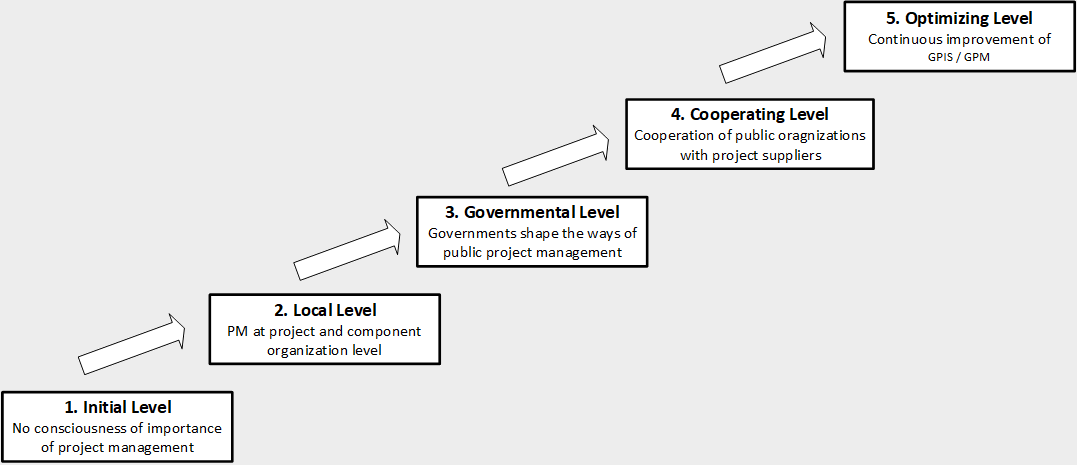Components
Governmental Project Management Maturity Model (GPM3®)
A maturity model is the sequence of groups (levels) of more and more efficient practices in any area of activity. Our base area for defining maturity levels are Governmental Project Implementation System and Governmental Project Management treated together as one system. The first source of our inspiration was Capability Maturity Model Integrated (CMMI ©) - probably the first widely recognized and probably best known maturity model. The second source of inspiration was Organizational Project Management Maturity Model (OPM3 ©) - a maturity model for the organizational level.
Initial Level
Some governments are (really!) not interested in managing their projects and investments. They think that it is enough to allocate the budget and set the deadline for product delivery and people will know how to do it. We say about such governments that they are at the lowest, Initial level of project management maturity.
Local Level
At some moment of time, people in individual governmental agencies and organizations, worried about continuous failures of their projects and inefficient work, learn that there exist efficient and effective methods of project management. After some time, they manage to convince the executives of their organizations that it is worth implementing these methods throughout all the organization. If project management methods are implemented only in some governmental organizations, we say that the given government has reached the Local level of project management maturity.
Governmental Level
After some time, the cabinet learns that in some of its organizations (or in foreign governments) projects are implemented more efficiently than anywhere else. This may result in the implementation of project management methods, techniques and processes as a way of working in all government's projects. This way, project management maturity in that state reaches the Governmental level.
Cooperating Level
But should the government only define the ways of project implementation and passively observe the results of these processes? It is better if the government be actively involved in the implementation of projects, like trying to solve problems faced by - usually complex and complicated - government's projects. Then we say that governmental project management has reached the Cooperating level.
Optimizing Level
But this is not the end of the journey to the top of the ladder of maturity. Everything can always be done better (if there is such a need). The most advanced governments - such as the US Federal Government - command its ministries and agencies to constantly improve project (and program) management processes. Then we say that given government has reached the Optimizing level of project management maturity.
And this description of progressively achieved levels of project management maturity (which can actually be observed in the development of some countries) is called the Government Project Management Maturity Model (GPM3®).

As projects are the main development tool for any organization - including governments and states - those of them which achieve higher level of project management maturity, develop faster, better meet the needs of their citizens.
The GPM3® may be used for three main purposes:
1. assessing the current state of project management (GPIS) in given jurisdiction,
2. showing the roadmap of GPIS improvement, and
3. comparing GPISs between governments.
To learn a little bit more about GPM3®, please turn to the Knowledge tab.
GPM3® is a trademark registered for Sybena Consulting Stanisław Gasik



